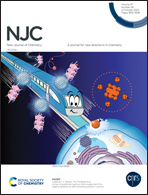Enhancement of the electrochemical properties of zinc–aluminium binary metal hydroxide nanosheets by the addition of activated carbon for pseudocapacitor electrode applications
Abstract
Metal hydroxides are extensively studied by researchers on account of the potential of these materials to be used in electrodes of energy storage devices. Remarkable electrochemical properties of nanostructured binary/ternary/quaternary metal hydroxides and their nanocomposites with carbonaceous materials prompted the investigation of these material groups for supercapacitor electrode applications. Zinc–aluminium binary hydroxide (ZAH) nanosheets and their nanocomposite with activated carbon (ZAH-AC) were synthesized by means of a hydrothermal method. X-Ray diffraction, selected area electron diffraction, Fourier transform infrared spectroscopy, and high resolution transmission electron microscopy were employed to study the basic characteristics of the synthesized samples. The electrochemical properties were studied using cyclic voltammetry, chronopotentiometry, and electrochemical impedance spectroscopy using a three-electrode system. At 1 A g−1 current density, ZAH and ZAH-AC nanosheets achieved specific capacitances of ∼159 F g−1 and ∼573 F g−1, respectively. A two-electrode system was utilized to confirm the workability of ZAH-AC as an electrode material. This system exhibited a high capacitance retention of 152% after 2000 charge–discharge cycles. The addition of AC to ZAH led to the enhancement of the specific capacitance without any crystal structural alterations in ZAH. The synergistic effect of the charge storage mechanisms of AC and ZAH resulted in a highly stable electrode material with pseudocapacitive behaviour.



 Please wait while we load your content...
Please wait while we load your content...